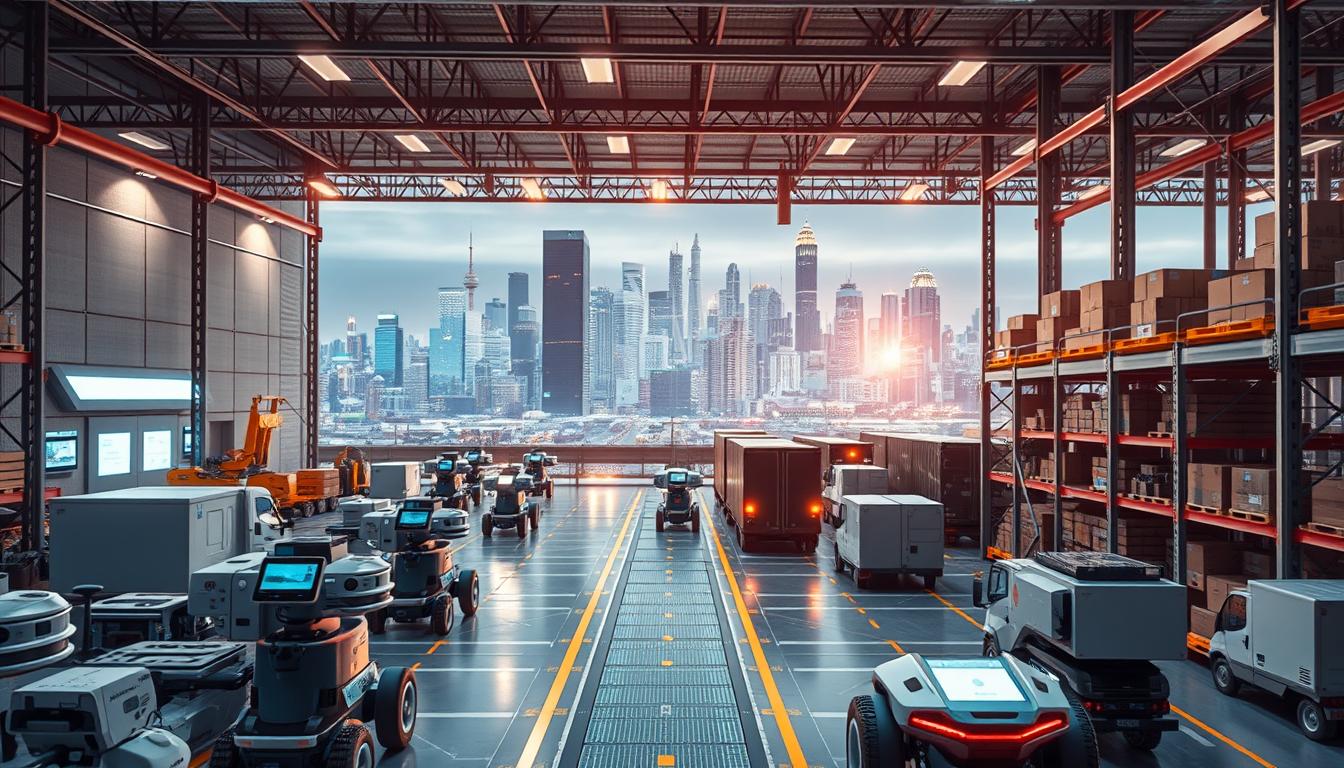AI in Supply Chain: Boosting Efficiency & Accuracy
Supply chains in the United States are under immense pressure to improve speed, reduce errors, and manage costs. Artificial intelligence is now a game-changer, bringing significant benefits to planning, logistics, and execution. Gartner predicts a doubling of machine automation in supply chain organizations within five years, marking a significant shift towards widespread adoption.
Investment in connected infrastructure is also on the rise. Industrial IoT platforms are expected to reach $17.41 billion by 2025, with a 40% CAGR over seven years. This investment supports the development of data pipelines essential for AI solutions in supply chain management, from tracking warehouse activities to monitoring fleet performance.
During the COVID-19 pandemic, McKinsey observed a 20–50% improvement in forecast accuracy with AI, highlighting the importance of real-time data over static plans.
Companies like Amazon and IBM are leading the way in leveraging machine learning, predictive analytics, computer vision, and natural language processing. These technologies enhance decision-making from sourcing to delivery.
Research in Frontiers in Artificial Intelligence backs these claims, showing reductions in cycle times and improvements in service levels. This article delves into the practical application of AI in supply chain management, focusing on adoption, data integration, and ROI tracking.
It offers a clear perspective on where digital transformation in supply chain yields the most benefits. These areas include demand forecasting, inventory optimization, route planning, quality control, and supplier collaboration. The analysis is grounded in evidence and designed to guide teams in scaling their capabilities with confidence.
What Is Artificial Intelligence in Supply Chain Management?
Artificial intelligence in supply chain refers to software that mimics human intelligence. It analyzes text, speech, images, and streaming signals to make data-driven decisions. This technology evaluates patterns at scale, connects operational data with market inputs, and supports quicker, more accurate decisions in planning and execution.
Defining AI, machine learning, and predictive analytics in supply chains
At its core, artificial intelligence in supply chain employs algorithms to interpret complex inputs and suggest next steps. Machine learning in supply chain enhances with more data, not fixed rules. This leads to more precise demand forecasts and inventory targets over time.
Predictive analytics in supply chain combines historical and real-time data to identify trends and probable outcomes. These abilities empower ai solutions for supply chain, leading to more accurate replenishment, sourcing, and fulfillment.
From reactive to proactive operations with real-time data
With real-time data on traffic, weather, inventory, and supplier performance, operations shift from reactive to proactive. Models assess lead-time risk, transit constraints, and capacity in minutes. They then suggest dynamic rerouting or automated replenishment.
Retailers, manufacturers, and carriers use artificial intelligence in supply chain to reduce latency. This cuts down stockouts and expedites costs while maintaining service levels.
Core capabilities: forecasting, optimization, automation, and decision support
Forecasting employs machine learning in supply chain—time series, regression, and gradient methods—to refine demand and safety stock. Optimization engines enhance routes, loads, slotting, and labor plans, balancing cost, service, and constraints.
Automation includes RPA for order entry and procurement tasks, plus AMRs for warehouse moves. This frees staff for exception work. Decision support highlights anomalies, runs scenario planning, and prioritizes actions. Predictive analytics in supply chain and ai solutions for supply chain together provide end-to-end visibility. This shortens cycle times and strengthens day-to-day control.
Why Speed Matters: Real-Time Decisions, Cycle-Time Reductions, and Continuous Improvement
Speed is key to maintaining service levels and protecting profit margins during times of volatility. Organizations that integrate ai into their supply chain workflows experience faster feedback loops and reduced cycle times.
This enables them to achieve weekly or even daily improvements. Such a shift aligns with digital transformation efforts that link planning, sourcing, and fulfillment to real-time data.
Speed as a competitive differentiator across planning, sourcing, and fulfillment
Quick updates in planning reduce buffer stock and shorten S&OP cycles from weeks to days. Suppliers are evaluated more swiftly, thanks to predictive analytics that highlight risks and lead-time trends. In fulfillment, optimization engines rebalance capacity across sites to meet tight delivery deadlines.
IIoT telemetry from various sources feeds alerts for immediate action. This turns dispatching, slotting, and dock scheduling into near real-time decisions. Such decisions help maintain throughput during demand spikes.
McKinsey and industry findings on AI-driven performance gains
McKinsey reports that companies using ai in their supply chains during the pandemic saw 20–50% better forecast accuracy. This accuracy leads to lower safety stock and reduced expedites. It shortens order-to-ship intervals and supports on-time delivery.
Industry case studies show that continuous learning on live data improves replenishment, routing, and capacity allocation week over week. As digital transformation in supply chain evolves, organizations standardize data pipelines. They deploy predictive analytics at scale, reinforcing faster responses across nodes.
From historical data to streaming signals for faster response
Switching from batch analytics to streaming inputs—such as traffic, weather, equipment condition, and supplier delays—enables earlier risk detection. Optimization models adjust plans mid-shift, compressing process times in S&OP, transport planning, and last-mile execution.
The expansion of Industrial IoT, expected to reach $17.41 billion by 2025, increases sensor coverage across fleets and facilities. This depth in sensor data strengthens ai in supply chain control towers. It provides granular, time-stamped signals for immediate corrective actions.
| Decision Area | Primary Signals | Action Window | Operational Effect |
|---|---|---|---|
| Demand Planning | POS trends, web traffic, promos | Hours to daily | Higher forecast accuracy, lower safety stock |
| Sourcing | Lead times, OTIF, geo-risk | Daily to weekly | Faster award decisions, reduced shortages |
| Transportation | Traffic, weather, driver status | Minutes to hours | Dynamic routing, fewer delays |
| Warehousing | Throughput, equipment health, labor | Minutes | Smoothed flows, less downtime |
| Last-Mile | Customer ETA, density, returns | Real time | Higher on-time rate, lower miles per stop |
AI in Supply Chain
ai in supply chain merges applied machine learning, computer vision, natural language processing, and predictive analytics. It integrates these technologies across ERP, WMS, TMS, and external data feeds.
Companies use these tools to automate tasks like invoice matching, carrier selection, and exception handling. This improves demand sensing and inventory accuracy, leading to faster, cheaper, and better service.
Amazon used AI-driven demand forecasting to manage network capacity and labor during the pandemic. IBM’s AI-powered supplier collaboration platforms track shipments and monitor supplier performance in real time. These solutions enable quicker decision-making and reduce manual work in planning and logistics.
In warehouses, co-bots and AMRs increase throughput by aligning with WMS task queues. Computer vision ensures quality control at receiving and packing. Predictive analytics adjust routing and inventory buffers based on weather, port congestion, and geopolitical signals. This shows Gartner’s prediction that machine automation will double, speeding up supply chain automation and reducing cycle times.
| Capability | Operational Use | Business Metric Impact | Example Providers |
|---|---|---|---|
| Demand Forecasting (ML) | Short-interval forecasts from POS, promotions, and seasonality | Lower stockouts; reduced markdowns | Amazon, SAP, Blue Yonder |
| Supplier Collaboration (AI Platform) | Real-time shipment tracking and risk alerts | Fewer late deliveries; higher on-time in-full | IBM, Coupa, Oracle |
| Warehouse Automation (AMRs & Co-bots) | Task orchestration for picking, replenishment, and packing | Higher lines per hour; shorter cycle times | Boston Dynamics, Locus Robotics, Zebra |
| Computer Vision QC | Automated defect detection at receiving and kitting | Fewer returns; improved first-pass yield | Microsoft, Google Cloud, Landing AI |
| Predictive ETA & Routing | Dynamic re-routing using traffic, weather, and capacity | Lower fuel cost; higher on-time delivery | Project44, FourKites, Descartes |
| Intelligent Automation (RPA + NLP) | Automated invoice matching and carrier tendering | Reduced processing time; fewer errors | UiPath, Automation Anywhere, SAP |
Companies standardize data across ERP, WMS, and TMS to support ai solutions. This leads to better planning and execution. As digital transformation in supply chain progresses, firms link forecasting to transportation and warehousing. This ensures automation aligns with KPIs for cost, service level, and resilience.
Key Technologies Powering Artificial Intelligence in Supply Chain
Leading enterprises use artificial intelligence in supply chain operations to enhance forecasts, reduce cycle times, and automate tasks. These efforts rely on strong data pipelines from various systems, including ERP, WMS, TMS, and IIoT sensors. Platforms from SAP, Microsoft, Google Cloud, and AWS then provide near-real-time recommendations.
By combining models with real-time data like traffic, weather, and market trends, teams receive accurate planning and logistics guidance. This approach leads to improved accuracy and faster issue resolution, thanks to machine learning and predictive analytics.
Machine learning for demand forecasting and inventory optimization
Regression, gradient boosting, and deep learning analyze historical sales, seasonality, promotions, and external factors to improve demand forecasts. These models set dynamic reorder points and optimize safety stock, reducing stockouts and excess.
Machine learning also optimizes inventory placement by aligning SKUs with service levels and lead times. Ai solutions for supply chain translate these insights into automated orders and balanced buffers at distribution centers.
Natural language processing to streamline procurement and supplier interactions
NLP extracts important information from contracts, improving compliance. It classifies spend, normalizes supplier names, and automates invoice matching, reducing cycle time and errors in accounts payable.
Chat-enabled agents handle supplier queries, summarize emails, and provide delivery status from ERP records. These tools, part of artificial intelligence in supply chain suites, standardize communication and reduce manual workload.
Computer vision for quality control and warehouse accuracy
High-resolution models inspect products on lines to detect defects and issues. In warehouses, vision systems verify counts, read barcodes quickly, and guide robotic picking by recognizing diverse SKUs.
Integrated with WMS, computer vision increases audit accuracy and reduces rework. It also supports safety by identifying hazards and monitoring equipment zones.
Predictive analytics to anticipate disruptions and support risk mitigation
Predictive analytics in supply chain combines internal and external data to forecast disruptions. It estimates delay probabilities and suggests mitigations like alternate sourcing or dynamic rerouting.
As IIoT expands, telemetry enables predictive maintenance for fleets and equipment. Ai solutions for supply chain operationalize these alerts, aligning plans and execution while keeping decisions timely and transparent.
These components form a unified decision layer that enhances planning precision and execution reliability. The architecture scales from pilot to enterprise as data quality and governance mature.
Operational Benefits: Efficiency, Accuracy, and Cost Reductions
Artificial intelligence in the supply chain boosts efficiency, reduces waste, and ensures quality at scale. McKinsey’s benchmarks show a 20–50% leap in forecast accuracy. Industry studies reveal 15–30% cuts in inventory costs through optimization and precise planning.
These improvements grow when automation aligns tasks across planning, sourcing, logistics, and service. This synchronization enhances overall performance.
Reduced operational costs via better forecasts, route optimization, and automation
Accurate forecasts prevent overproduction and stockouts, lowering costs. Route optimization reduces fuel consumption and mileage. Automation minimizes manual errors and labor hours in various tasks.
Enhanced transparency and end-to-end visibility with real-time monitoring
Real-time monitoring tracks inventory and shipment status. Control towers identify bottlenecks early, enabling quick adjustments. AI in the supply chain helps teams manage exceptions and align production with demand.
Faster response times and improved customer satisfaction
Predictive signals adjust procurement and production as demand changes. Integrated workflows update carriers and customers, improving service levels. This leads to fewer errors, tighter ETAs, and higher on-time delivery rates.
Scalability, flexibility, and risk mitigation in volatile markets
Artificial intelligence in the supply chain scales without performance loss. It quickly adapts to new regulations and market changes. AI helps identify and mitigate risks, ensuring supply chain resilience.
| Operational Lever | Primary Mechanism | Measured Outcome | Representative Tools |
|---|---|---|---|
| Forecast Accuracy | Machine learning on POS, ERP, and external signals | 20–50% accuracy improvement (McKinsey) | Amazon Forecast, SAS Demand Planning |
| Inventory Optimization | Multi-echelon policies and safety stock tuning | 15–30% carrying cost reduction | Kinaxis RapidResponse, Blue Yonder Luminate |
| Route and Load Planning | Dynamic routing and consolidation | Fuel and mileage reductions; fewer empty miles | Oracle Transportation Management, Descartes |
| Process Automation | RPA for orders, invoices, and ASN matching | Lower labor hours and error rates | UiPath, Automation Anywhere |
| Real-Time Visibility | IoT, telematics, and event streaming | Earlier exception detection; accurate ETAs | Project44, FourKites |
| Risk Mitigation | Supplier scoring and predictive alerts | Fewer disruptions and faster recovery | Resilinc, Everstream Analytics |
Applications Across Logistics: Transportation, Warehousing, and Last-Mile
Enterprises leverage ai solutions for supply chain operations to expedite decision-making across various sectors. These systems combine predictive analytics and machine learning to optimize tasks. This results in significant reductions in miles, delays, and improved service levels.
Smart route optimization using traffic, weather, delivery windows, and capacity
Advanced dispatch engines analyze real-time traffic, weather, and delivery commitments. They also consider vehicle capacity and driver hours. This planning optimizes routes, ensuring service level agreements are met.
Models continually learn from outcomes, refining routes and pairing backhaul operations. Fleets use predictive analytics to minimize empty miles and enhance on-time delivery.
Telematics and ELD data enable predictive maintenance, identifying asset risks early. This approach reduces roadside issues and stabilizes schedules, supporting efficient routing cycles.
Warehouse intelligence: slotting, AMRs, and IoT-enabled visibility
In high-volume warehouses, machine learning optimizes slotting based on pick frequency and size. Autonomous mobile robots from Zebra and Locus Robotics accelerate picking. Computer vision ensures accurate counts, reducing mis-picks.
IoT sensors monitor inventory conditions and security. These ai solutions integrate with WMS data, providing real-time visibility. This boosts flow and labor productivity.
Last-mile innovations: dynamic rerouting, predictive ETAs, and autonomous delivery
Last-mile platforms offer predictive ETAs that adjust to traffic changes. In case of disruptions, the system quickly reroutes drivers. Couriers use geofencing and micro-fulfillment to reduce travel distances.
Autonomous pilots, like Amazon’s drones, navigate through complex environments. This showcases how machine learning supports accurate delivery at high volumes.
Sustainability wins: fuel, emissions, and space utilization
Smarter routing reduces fuel consumption and emissions per stop. Load-building algorithms optimize trailer and container fill. Predictive analytics forecast demand, reducing waste and improving packaging efficiency.
Industry-wide deployments have led to faster deliveries and lower emissions. This is thanks to ai solutions for routing and loading.
Building Resilience with AI: Forecast Accuracy, Automation, and Collaboration
Recent shocks have exposed the fragility of global networks. Now, resilience is a core metric for organizations, not just a secondary goal. By leveraging ai in supply chain, companies can turn noise into actionable signals, leading to faster responses.
This transformation marks a significant shift in supply chain operations. Teams now integrate predictive analytics and event monitoring to maintain service levels and protect margins. As ai tools advance, response times shorten, and variability decreases.
Predictive risk sensing from weather to geopolitical signals
Resilient networks combine satellite weather, port congestion, and customs alerts with macroeconomic data. Machine learning assesses risk, identifying high-risk lanes, suppliers, and SKUs. This approach forecasts lead-time drift, capex exposure, and service risks early on.
Operational dashboards focus on material threats. Teams receive detailed playbooks for rerouting, dual sourcing, and inventory hedges. These plans align ai insights with financial constraints.
McKinsey-reported 20–50% gains in forecast accuracy with AI adoption
During the pandemic, McKinsey found 20–50% improvements in forecast accuracy for AI adopters. These gains led to fewer stockouts and lower expedited freight costs. Amazon’s AI-driven demand planning exemplifies how ai can scale during sudden demand spikes.
These outcomes stem from models that incorporate real-time signals, not just historical data. This results in tighter safety-stock bands and enhanced on-time, in-full performance.
Automation for faster, coordinated responses to disruptions
Automation connects alerts to actions. Warehouse systems adjust slotting and labor allocation dynamically. Transportation platforms initiate rebooking when capacity is tight. Procurement bots launch RFQs for at-risk parts and monitor supplier confirmations.
By reducing manual touchpoints, ai in supply chain shortens cycle time from detection to action. Exceptions become managed workflows, preserving service while controlling costs.
Real-time supplier collaboration platforms for visibility and performance
IBM’s AI-enhanced supplier solutions showcase the benefits of shared data. Partners see real-time shipment status, ASN quality, and quality metrics, with alerts for delays or defects. This transparency supports digital transformation in supply chain governance and enables faster corrective actions.
Collaboration tools align forecasts, capacity plans, and inventory buffers across tiers. As ai surfaces anomalies, teams coordinate responses that limit downtime and revenue risk.
Implementation Roadmap: From Data Foundations to Scalable AI Solutions
Aligning technology with business value is key to success. The roadmap outlines steps from setting objectives to delivering scalable AI solutions. It guides the digital transformation of supply chains and scales AI solutions with clear outcomes.
Set measurable goals: demand forecasting, route and inventory optimization, risk
Establish goals tied to profit and loss metrics. Focus on improving forecast accuracy, service levels, and logistics costs. Also, aim for better inventory turns and lower risk exposure, such as supplier on-time-in-full (OTIF) and disruption lead time. Connect these goals to machine learning and predictive analytics in supply chain.
Collect, clean, and govern data across ERP, WMS, TMS, and external sources
Integrate data from SAP or Oracle ERP, Manhattan or Blue Yonder WMS, and TMS with external signals like weather and traffic. Set up data governance and master data management for products, locations, and partners. Also, establish quality protocols for data preparation and formatting.
Select algorithms and tools: regression, clustering, deep learning, RPA, computer vision
Choose the right methods for each problem. Use regression and gradient boosting for forecasting and price-volume effects. Clustering is good for network segmentation, while deep learning handles complex demand patterns. RPA automates transactions, and computer vision checks quality and counts inventory. NLP streamlines procurement and supplier communication.
Integrate, test, pilot, and iterate for continuous improvement
Connect models to ERP, WMS, and TMS via APIs or middleware. Use streaming architectures for real-time data. Validate models against actual data, then pilot them in a limited scope. Refine parameters and thresholds based on feedback. Retrain models on new data, expand use cases, and scale once ROI is proven. This ensures continuous improvement in digital transformation and AI solutions.
Overcoming Integration and Change Management Challenges
Successful programs combine technology expertise with disciplined execution. Teams working on digital transformation in supply chain and automation must align architecture with governance. This ensures ai in supply chain and artificial intelligence in supply chain scale smoothly without disruption.

Data quality, standardization, and master data management
Strong data practices begin with governance, standardized schemas, and automated pipelines. Master data management for products, locations, suppliers, and customers minimizes duplication and latency.
Integrate data from SAP, Oracle, Microsoft Dynamics 365, 3PL portals, and supplier EDI. Create data-sharing agreements that outline ownership, privacy, and usage rights. This supports artificial intelligence in supply chain and ensures consistent analytics.
Legacy systems, APIs, and real-time processing architectures
Many legacy ERP and WMS platforms lack modern APIs. Modular middleware, event streaming, and selective upgrades fill these gaps while ensuring uptime.
High-value use cases like dynamic routing and automated exception handling require real-time processing. Kafka-style streaming and microservices enable ai in supply chain to respond to live signals from TMS, IoT sensors, and carrier feeds.
Organizational readiness: stakeholder alignment, training, and phased rollouts
Engage operations, finance, IT, procurement, and logistics early to align on scope and outcomes. Targeted training boosts proficiency and ensures consistent tool use.
Phased rollouts offer quick wins that reinforce digital transformation in supply chain. Pilots in a single region or product line de-risk scale while refining playbooks for automation in supply chain.
Measuring ROI and securing long-term adoption
Monitor metrics that reflect value: forecast accuracy, inventory turns, OTIF, transportation cost per mile, labor productivity, and service levels. Benchmark before-and-after results and update baselines as capabilities evolve.
Standardized measurement builds confidence in artificial intelligence in supply chain and sustains funding. Governance councils should review variance drivers, codify lessons, and prioritize the next wave of ai in supply chain use cases.
- Data governance: stewardship roles, quality thresholds, and audit logs
- Integration: API gateways, message queues, and schema registries
- Change enablement: role-based training, SOP updates, and support desks
- Value tracking: aligned KPIs, quarterly reviews, and benefits realization
Conclusion
AI in supply chain operations has evolved from experimental phases to established practices. McKinsey highlights a 20–50% improvement in forecast accuracy, underscoring the tangible benefits in planning, logistics, and delivery. As industrial IoT grows and automation expands, AI transforms supply chain networks from reactive to proactive, boosting speed, precision, and resilience.
Success hinges on robust data foundations. Companies that manage master data and integrate ERP, WMS, and TMS with AI technologies see significant cost savings and enhanced transparency. Platforms adopted by IBM and other giants demonstrate the value of embedding AI solutions in daily operations, fostering collaboration, risk detection, and swift responses.
Implementation is key. Phased deployments, structured training, and defined KPIs lead to quick returns and scalable benefits. With automation set to double and investment in connected platforms increasing, supply chain optimization will accelerate. This includes dynamic routing and near real-time inventory management.
The path forward is clear: AI in supply chain is now a fundamental capability. Organizations that prioritize data discipline, modernize integrations, and expand AI use cases will gain a lasting competitive edge in the U.S. and globally. They will turn volatility into a manageable, measurable advantage.
FAQ
How does artificial intelligence in supply chain improve efficiency and accuracy?
AI boosts efficiency by automating tasks in planning, procurement, and execution. Machine learning enhances forecast accuracy and optimizes inventory. Predictive analytics shifts operations to real-time, reducing cycle times in various areas.
What measurable gains have companies reported from AI adoption?
McKinsey found 20–50% better forecast accuracy during COVID-19. Studies show 15–30% inventory cost cuts from optimization. Gartner predicts machine automation will double in five years, showing rapid adoption.
Which core capabilities matter most for planning and logistics?
Key areas include demand forecasting with ML, supply chain optimization, and automation. Decision support systems manage exceptions and scenario planning across different systems to maintain service levels.
How do real-time signals enable proactive operations?
AI models use streaming data for dynamic rerouting and automated replenishment. Industrial IoT investments provide continuous monitoring and faster responses.
What are practical examples from leading companies?
Amazon uses AI for demand sensing to scale fulfillment and improve ETAs. IBM’s AI solutions track supplier performance in real-time, reducing downtime and speeding up corrective actions.
Which data foundations are required to scale AI solutions?
Strong data governance and standardized schemas are essential. Unified pipelines and APIs connect systems for low-latency decisions.
How do machine learning and predictive analytics reduce logistics costs?
ML improves forecasts and safety stocks to reduce stockouts and excess. Predictive analytics optimizes routing, lowering costs and improving metrics.
What role does computer vision play in warehouse and quality operations?
Computer vision checks product quality and supports robotic picking. It boosts inventory accuracy, reduces errors, and speeds up cycle counting.
How does NLP streamline procurement and finance workflows?
NLP extracts terms from contracts and automates supplier queries and invoice matching. This leads to faster cycle times and better compliance.
How can organizations measure ROI for AI initiatives?
Track various KPIs like forecast accuracy and inventory turns. Pilot and validate against actuals to expand use cases.
What integration challenges commonly arise and how are they addressed?
Legacy systems and fragmented data pose challenges. Solutions include modular middleware and data-sharing agreements for interoperability.
How does AI strengthen resilience against disruptions?
Predictive risk sensing detects threats early. Automation and collaboration platforms ensure sustained service levels during disruptions.
What sustainability outcomes can AI deliver?
AI optimizes supply chain, reducing miles and emissions. It also lowers waste from overproduction and obsolescence.
What is the recommended roadmap to implement digital transformation in supply chain?
Define goals, prioritize ROI, and build governed datasets. Select algorithms, integrate systems, and run pilots. Maintain continuous improvement through retraining and scaling.
Where does predictive maintenance fit within AI-enabled logistics?
Predictive maintenance models forecast component failures. It reduces downtime, stabilizes throughput, and protects delivery SLAs with lower costs.






